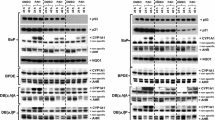Abstract
Hepatic aryl hydrocarbon hydroxylase (AHH)-inducing potency of toxic polychlorinated aromatic hydrocarbons such as polychlorinated dibenzofurans (PCDFs), 3,4,5,3′,4′,5′-hexachlorobiphenyl (HCB) and 2,3,7,8-tetrachlorodibenzo-p-dioxin (TCDD) was studied in four inbred strains of mice with different phenotypes of Ah locus, i.e., AHH-responsive strains: C57BL/6N and AKR/Ms Qdj, and AHH-nonresponsive strains: DBA/2Cr Slc and Qdj; DDD. Eight individual PCDF isomers or TCDD were administered IP in doses of 30 μg/kg; HCB was given in a dose of 120 μg/kg. In AHH-nonresponsive strains of mice, only TCDD significantly induced hepatic AHH activity, while in AHH-responsive strains, 2,3,7,8-tetrachlorodibenzofuran(2,3,7,8-TCDF), 1,2,3,7,8-pentachlorodibenzofuran(1,2,3,7,8-PCDF) 2, 3, 4, 7, 8-pentachlorodibenzofuran (2, 3,4, 7, 8-PCDF), and TCDD significantly enhanced the enzyme activity, and the induced AHH activities with the three PCDF isomers were about 30–65% of those of TCDD. These results indicate that AHH responsiveness in mice segregates with the induction of AHH activity by PCDF isomers and may also segregate with the toxic potency of the isomers; i.e., toxic potencies of 2,3,7,8-TCDF, 1,2,3,7,8-PCDF, and 2,3,4,7,8-PCDF in AHH-responsive strains of mice may be much greater than those in AHH-nonresponsive strains of mice. Taking into account both the potent AHH inducibility and the high bioaccumulation of 2,3,7,8-TCDF, 1,2,3,7,8-PCDF, and 2,3,4,7,8-PCDF, these three PCDF isomers should be given greater attention with regard to environmental contamination.
Similar content being viewed by others
References
Buser HR, Bosshardt H-P, Rappe C (1978a) Formation of polychlorinated dibenzofurans (PCDFs) from the pyrolysis of PCBs. Chemosphere 7: 109–119
Buser HR, Bosshardt H-P, Rappe C, Lindahl R (1978b) Identification of polychlorinated dibenzofuran isomers in fly ash and PCB pyrolyses. Chemosphere 7: 419–429
Katoh H, Esaki K, Shoji Y, Nomura T, Moriwaki K, Yonekawa H (1984) Demonstration of genetic profiles in various lines of NZB and AKR by a genetic monitoring system. Proceedings of 8th international counsel of laboratory animal science (in press)
Kodama Y, Bock FG (1970) Benzo[α]pyrene-metabolizing activity of livers of various strains of mice. Cancer Res 30: 1846–1849
Kunita N, Hori S, Obana H, Otake T, Nishimura H, Kashimoto T, Ikegami N (1983) Biological effect of PCBs, PCQs and PCDFs present in the causal oil. In the Japan-U.S. Joint Seminar on Toxicity of Chlorinated Biphenyls, Dibenzofurans, Dibenzodioxins and Related Compounds, Fukuoka, Japan, April 25–28
Kuroki H, Masuda Y (1978) Determination of polychlorinated dibenzofuran isomers retained in patients with Yusho. Chemosphere 7: 771–777
Lowry OH, Rosebrough NJ, Farr AL, Randall RJ (1951) Protein measurements with the Folin phenol reagent. J Biol Chem 193: 265–275
Nagayama J, Kuratsune M, Masuda Y (1976) Determination of chlorinated dibenzofurans in Kanechlors and “Yusho oil”. Bull Environ Contam Toxicol 15: 9–13
Nagayama J, Masuda Y, Kuratsune M (1977) Determination of polychlorinated dibenzofurans in tissues of patients with ‘Yusho’. Fd Cosmet Toxicol 15: 195–198
Nagayama J, Kuroki H, Masuda Y, Kuratsune M (1983) A comparative study of polychlorinated dibenzofurans, polychlorinated biphenyls and 2,3,7,8-tetrachlorodibenzo-p-dioxin on aryl hydrocarbon hydroxylase inducing potency in rats. Arch Toxicol 53: 177–184
Nagayama J, Kiyohara C, Kuratsune M, Masuda Y (1984) Induction of aryl hydrocarbon hydroxylase activity in human lymphoblastoid cells by chlorinated dibenzofuran isomers and 2,3,7,8-tetrachlorodibenzo-p-dioxin. In: Keith LH (ed) Chlorinated dioxins and dibenzofurans in the total environment (II). Ann Arbor Science Publishers, Ann Arbor (in press)
Nebert DW, Goujon FM, Gielen JE (1972) Aryl hydrocarbon hydroxylase induction by polycyclic hydrocarbons: Simple autosomal dominant trait in the mouse. Nature New Biol 236: 107–110
Nebert DW, Robinson JR, Niwa A, Kumaki K, Poland A (1975) Genetic expression of aryl hydrocarbon hydroxylase activity in the mouse. J Cell Physiol 85: 393–414
Olie K, Vermeulen PL, Hutzinger O (1977) Chlorodibenzo-p-dioxins and chlorodibenzofurans are trace components of fly ash and flue gas of some municipal incinerators in the Netherlands. Chemosphere 6: 455–459
Poland A, Glover E (1973) Chlorinated dibenzo-p-dioxins: Potent inducers of δ-aminolevulinic acid synthetase and aryl hydrocarbon hydroxylase. II. A study of the structure-activity relationship. Mol Pharmacol 9: 736–747
Poland A, Glover E (1974) Comparison of 2,3,7,8-tetrachlorodibenzo-p-dioxin, a potent inducer of aryl hydrocarbon hydroxylase with 3-methylcholanthrene. Mol Pharmacol 10: 349–359
Poland A, Glover E (1975) Genetic expression of aryl hydrocarbon hydroxylase by 2,3,7,8-tetrachlorodibenzo-p-dioxin: Evidence for a receptor mutation in genetically nonresponsive mice. Mol Pharmacol 11: 389–398
Rappe C, Buser HR, Kuroki H, Masuda Y (1979) Identification of polychlorinated dibenzofurans (PCDFs) retained in patients with Yusho. Chemosphere 8: 259–266
Rappe C, Buser HR, Stalling DL, Smith LM, Dougherty RC (1981) Identification of polychlorinated dibenzofurans in environmental samples. Nature 292: 524–526
Yoshihara S, Nagata K, Yoshimura H, Kuroki H, Masuda Y (1981) Inductive effect on hepatic enzymes and acute toxicity of individual polychlorinated dibenzofuran congeners in rats. Toxicol Appl Pharmacol 59: 580–588
Yoshimura H, Yoshihara S, Ozawa N, Miki M (1979) Possible correlation between induction modes of hepatic enzymes by PCBs and their toxicity in rats. Ann NY Acad Sci 320: 179–192
Author information
Authors and Affiliations
Rights and permissions
About this article
Cite this article
Nagayama, J., Kuroki, H., Masuda, Y. et al. Genetically mediated induction of aryl hydrocarbon hydroxylase activity in mice by polychlorinated dibenzofuran isomers and 2,3,7,8-tetrachlorodibenzo-p-dioxin. Arch Toxicol 56, 226–229 (1985). https://doi.org/10.1007/BF00295158
Received:
Accepted:
Issue Date:
DOI: https://doi.org/10.1007/BF00295158




